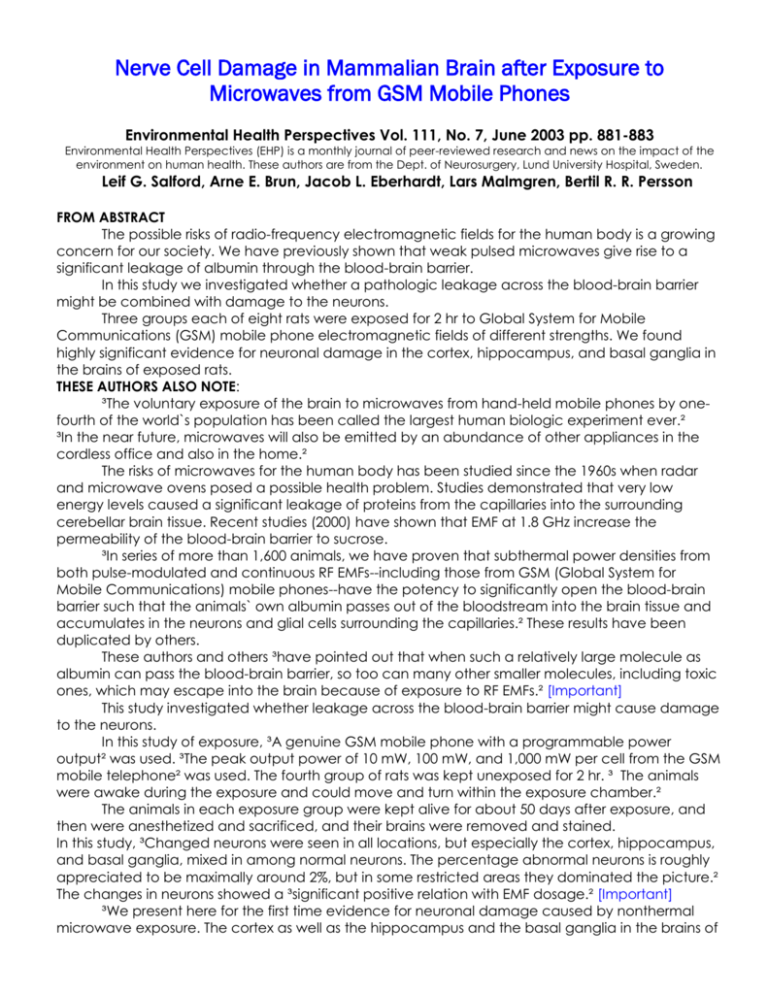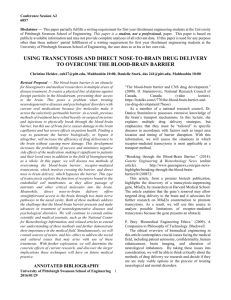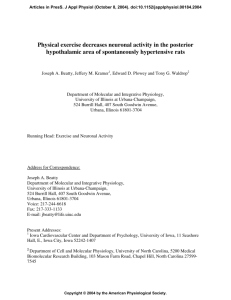Nerve Cell Damage in Mammalian Brain after Exposure to
advertisement

Nerve Cell Damage in Mammalian Brain after Exposure to Microwaves from GSM Mobile Phones Environmental Health Perspectives Vol. 111, No. 7, June 2003 pp. 881-883 Environmental Health Perspectives (EHP) is a monthly journal of peer-reviewed research and news on the impact of the environment on human health. These authors are from the Dept. of Neurosurgery, Lund University Hospital, Sweden. Leif G. Salford, Arne E. Brun, Jacob L. Eberhardt, Lars Malmgren, Bertil R. R. Persson FROM ABSTRACT The possible risks of radio-frequency electromagnetic fields for the human body is a growing concern for our society. We have previously shown that weak pulsed microwaves give rise to a significant leakage of albumin through the blood-brain barrier. In this study we investigated whether a pathologic leakage across the blood-brain barrier might be combined with damage to the neurons. Three groups each of eight rats were exposed for 2 hr to Global System for Mobile Communications (GSM) mobile phone electromagnetic fields of different strengths. We found highly significant evidence for neuronal damage in the cortex, hippocampus, and basal ganglia in the brains of exposed rats. THESE AUTHORS ALSO NOTE: ³The voluntary exposure of the brain to microwaves from hand-held mobile phones by onefourth of the world`s population has been called the largest human biologic experiment ever.² ³In the near future, microwaves will also be emitted by an abundance of other appliances in the cordless office and also in the home.² The risks of microwaves for the human body has been studied since the 1960s when radar and microwave ovens posed a possible health problem. Studies demonstrated that very low energy levels caused a significant leakage of proteins from the capillaries into the surrounding cerebellar brain tissue. Recent studies (2000) have shown that EMF at 1.8 GHz increase the permeability of the blood-brain barrier to sucrose. ³In series of more than 1,600 animals, we have proven that subthermal power densities from both pulse-modulated and continuous RF EMFs--including those from GSM (Global System for Mobile Communications) mobile phones--have the potency to significantly open the blood-brain barrier such that the animals` own albumin passes out of the bloodstream into the brain tissue and accumulates in the neurons and glial cells surrounding the capillaries.² These results have been duplicated by others. These authors and others ³have pointed out that when such a relatively large molecule as albumin can pass the blood-brain barrier, so too can many other smaller molecules, including toxic ones, which may escape into the brain because of exposure to RF EMFs.² [Important] This study investigated whether leakage across the blood-brain barrier might cause damage to the neurons. In this study of exposure, ³A genuine GSM mobile phone with a programmable power output² was used. ³The peak output power of 10 mW, 100 mW, and 1,000 mW per cell from the GSM mobile telephone² was used. The fourth group of rats was kept unexposed for 2 hr. ³ The animals were awake during the exposure and could move and turn within the exposure chamber.² The animals in each exposure group were kept alive for about 50 days after exposure, and then were anesthetized and sacrificed, and their brains were removed and stained. In this study, ³Changed neurons were seen in all locations, but especially the cortex, hippocampus, and basal ganglia, mixed in among normal neurons. The percentage abnormal neurons is roughly appreciated to be maximally around 2%, but in some restricted areas they dominated the picture.² The changes in neurons showed a ³significant positive relation with EMF dosage.² [Important] ³We present here for the first time evidence for neuronal damage caused by nonthermal microwave exposure. The cortex as well as the hippocampus and the basal ganglia in the brains of exposed rats contained damaged neurons. We realize that our study comprises few animals, but the combined results are highly significant and exhibit a clear dose-response relation.² The findings in this study ³would seem to indicate serious neuronal damage, which may be mediated through organelle damage with release of not only hydrolytic lysosomal enzymes but also, for example, sequestered harmful material, such as heavy metals, stored away in cytoplasmic organelles (lysosomes).² These authors note that from previous studies, the initial albumin leakage into the brain tissue was observed within hours in 40% of exposed animals, and continued for 8 weeks after the exposure. This leakage is probably subsequent to a breach of the blood-brain barrier. These authors chose 12-26 week-old rats because they are comparable with human teenagers‹³notably frequent users of mobile phones.² ³The situation of the growing brain might deserve special concern from society because biologic and maturational processes are particularly vulnerable during the growth process. The intense use of mobile phones by youngsters is a serious consideration. A neuronal damage of the kind described here may not have immediately demonstrable consequences. In the long run, it may result in reduced brain reserve capacity that might be unveiled by other later neuronal disease or even the wear and tear of aging. We cannot exclude that after some decades of (often) daily use, a whole generation of users may suffer negative effects, perhaps as early as in middle age.² KEY POINTS FROM DAN MURPHY: 1) The voluntary exposure of the brain to microwaves from hand-held mobile phones by one-fourth of the world`s population is the largest human biologic experiment ever. 2) In the near future, microwaves will also be emitted by an abundance of other appliances in the cordless office and home. 3) Importantly, this study used standard current generation cell phones and exposed rats to their EMFs only one time, for 2 continuous hours. 4) In these rats, at common exposures of human teenagers, there was significant leakage of protein and sugar through the blood-brain barrier, combined with damage to the neurons in the cortex, hippocampus, and basal ganglia. 5) There was a significant and clear dose-response to cell phone EMF exposure and neuronal damage. This means the longer the exposure the greater the damage. 6) If a large molecule like albumin can pass through the blood-brain barrier after cell phone EMF exposure, then many other smaller toxic molecules can also do so. 7) The serious neuronal damage documented in this study is probably related to organelle injury, which can release sequestered harmful heavy metal toxins. 8) The damage caused by cell phone EMF exposure can be seen within hours of exposure. 9) Growing brains are more vulnerable to cell phone EMF exposure. 10) The neuronal damage documented in this study may not be immediately demonstrable in humans, but may later reduced the brain¹s function, resulting in neuronal disease and accelerated brain aging. 11) After decades of cell phone use, a whole generation of users may suffer negative effects, perhaps as early as in middle age. 12) This study presents for the first time evidence for neuronal damage caused by nonthermal cell phone microwave exposure.











